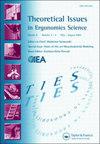Gaze behaviours engaged while taking over automated driving: a systematic literature review
IF 1.4
Q4 ERGONOMICS
引用次数: 1
Abstract
Abstract Among highly automated driving research topics, transition of control, especially from automated to manual driving (i.e., takeover) have been the object of numerous studies. Drivers’ gaze behaviours are of particular interest as proper information processing by the driver is a key element to safe manual control resumption. In this study, 22 research articles were selected and reviewed to extract main gaze behaviours tendencies during takeover transitions. Despite a great variety in protocols and gaze metrics, categories of factors and gaze parameters have been established. The resulting data shows that at the onset of the takeover request gaze tend to be quickly reoriented towards the road ahead. Despite this, an increase in gaze dispersion on the road environment was found in automated driving. In addition, clear evidence for detrimental effects of visually engaging non-driving related activities on visual exploration strategies emerge (e.g., delay in reorienting the gaze towards the road ahead). Altogether, gaze data reveal the complexity of information processing during takeovers. A synthetical view of gaze parameters evolution during the takeover process has been established and associated with visual information gathering and processing. Finally, a broader view underlying the importance of combining technological approaches with human centred ones is proposed. Supplemental data for this article is available online at at http://doi:10.1080/1463922X.2022.2036861 .接管自动驾驶时的凝视行为:系统的文献综述
在高度自动化驾驶的研究课题中,控制的过渡,特别是从自动驾驶到手动驾驶的过渡(即接管)一直是众多研究的对象。驾驶员的注视行为特别有趣,因为驾驶员适当的信息处理是安全手动控制恢复的关键因素。本研究选取了22篇相关研究论文,并对其进行了回顾,以提取收购转换过程中的主要凝视行为倾向。尽管有各种各样的协议和凝视指标,但已经建立了因素和凝视参数的类别。由此得出的数据表明,在收购请求开始时,目光往往会迅速转向前方的道路。尽管如此,在自动驾驶中,人们在道路环境中的视线分散程度有所增加。此外,有明确证据表明,视觉参与与驾驶无关的活动对视觉探索策略有不利影响(例如,延迟将目光转向前方道路)。总之,凝视数据揭示了收购过程中信息处理的复杂性。在接管过程中,注视参数的演化与视觉信息的收集和加工有关。最后,提出了一种更广泛的观点,说明将技术方法与以人为本的方法结合起来的重要性。本文的补充数据可在http://doi:10.1080/1463922X.2022.2036861上在线获得。
本文章由计算机程序翻译,如有差异,请以英文原文为准。
求助全文
约1分钟内获得全文
求助全文

 求助内容:
求助内容: 应助结果提醒方式:
应助结果提醒方式:


